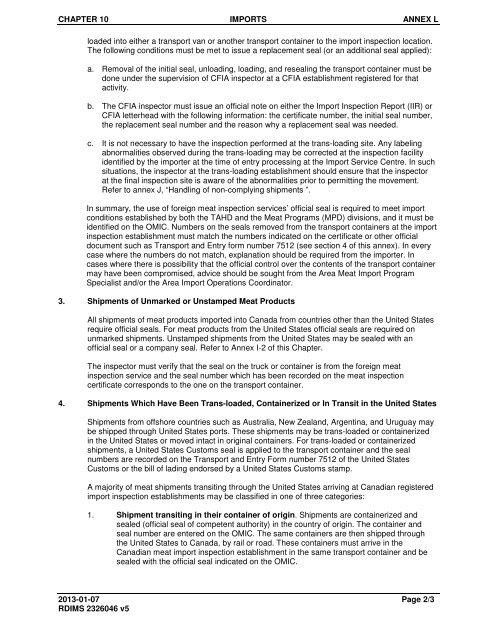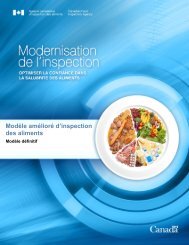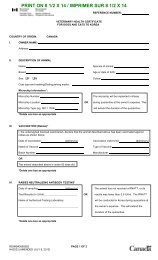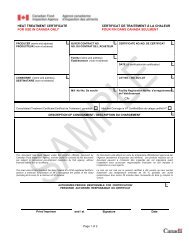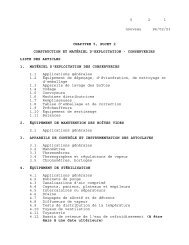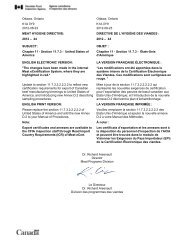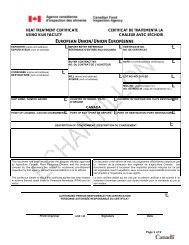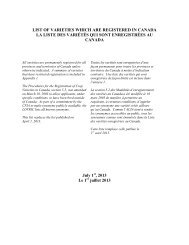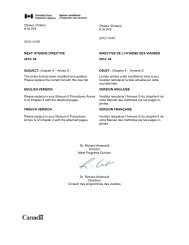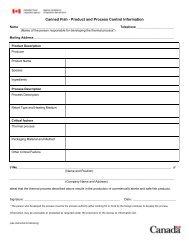PDF (342 kb ) - Agence canadienne d'inspection des aliments
PDF (342 kb ) - Agence canadienne d'inspection des aliments
PDF (342 kb ) - Agence canadienne d'inspection des aliments
Create successful ePaper yourself
Turn your PDF publications into a flip-book with our unique Google optimized e-Paper software.
CHAPTER 10 IMPORTS ANNEX Lloaded into either a transport van or another transport container to the import inspection location.The following conditions must be met to issue a replacement seal (or an additional seal applied):a. Removal of the initial seal, unloading, loading, and resealing the transport container must bedone under the supervision of CFIA inspector at a CFIA establishment registered for thatactivity.b. The CFIA inspector must issue an official note on either the Import Inspection Report (IIR) orCFIA letterhead with the following information: the certificate number, the initial seal number,the replacement seal number and the reason why a replacement seal was needed.c. It is not necessary to have the inspection performed at the trans-loading site. Any labelingabnormalities observed during the trans-loading may be corrected at the inspection facilityidentified by the importer at the time of entry processing at the Import Service Centre. In suchsituations, the inspector at the trans-loading establishment should ensure that the inspectorat the final inspection site is aware of the abnormalities prior to permitting the movement.Refer to annex J, “Handling of non-complying shipments ”.In summary, the use of foreign meat inspection services’ official seal is required to meet importconditions established by both the TAHD and the Meat Programs (MPD) divisions, and it must beidentified on the OMIC. Numbers on the seals removed from the transport containers at the importinspection establishment must match the numbers indicated on the certificate or other officialdocument such as Transport and Entry form number 7512 (see section 4 of this annex). In everycase where the numbers do not match, explanation should be required from the importer. Incases where there is possibility that the official control over the contents of the transport containermay have been compromised, advice should be sought from the Area Meat Import ProgramSpecialist and/or the Area Import Operations Coordinator.3. Shipments of Unmarked or Unstamped Meat ProductsAll shipments of meat products imported into Canada from countries other than the United Statesrequire official seals. For meat products from the United States official seals are required onunmarked shipments. Unstamped shipments from the United States may be sealed with anofficial seal or a company seal. Refer to Annex I-2 of this Chapter.The inspector must verify that the seal on the truck or container is from the foreign meatinspection service and the seal number which has been recorded on the meat inspectioncertificate corresponds to the one on the transport container.4. Shipments Which Have Been Trans-loaded, Containerized or In Transit in the United StatesShipments from offshore countries such as Australia, New Zealand, Argentina, and Uruguay maybe shipped through United States ports. These shipments may be trans-loaded or containerizedin the United States or moved intact in original containers. For trans-loaded or containerizedshipments, a United States Customs seal is applied to the transport container and the sealnumbers are recorded on the Transport and Entry Form number 7512 of the United StatesCustoms or the bill of lading endorsed by a United States Customs stamp.A majority of meat shipments transiting through the United States arriving at Canadian registeredimport inspection establishments may be classified in one of three categories:1. Shipment transiting in their container of origin. Shipments are containerized andsealed (official seal of competent authority) in the country of origin. The container andseal number are entered on the OMIC. The same containers are then shipped throughthe United States to Canada, by rail or road. These containers must arrive in theCanadian meat import inspection establishment in the same transport container and besealed with the official seal indicated on the OMIC.2013-01-07 Page 2/3RDIMS 2326046 v5


